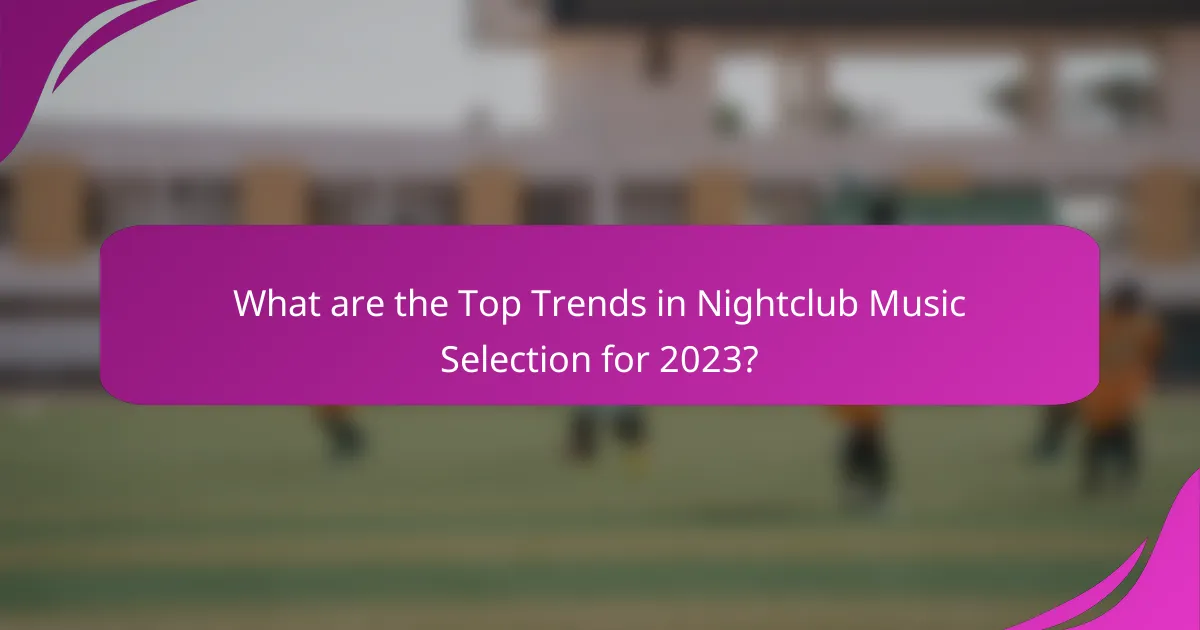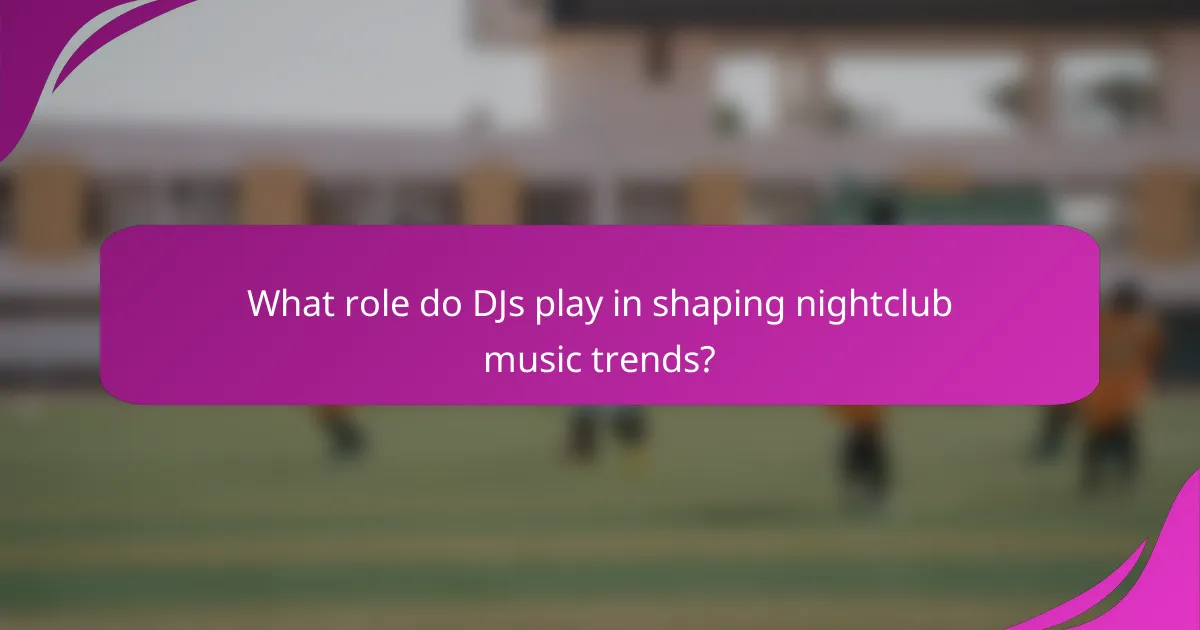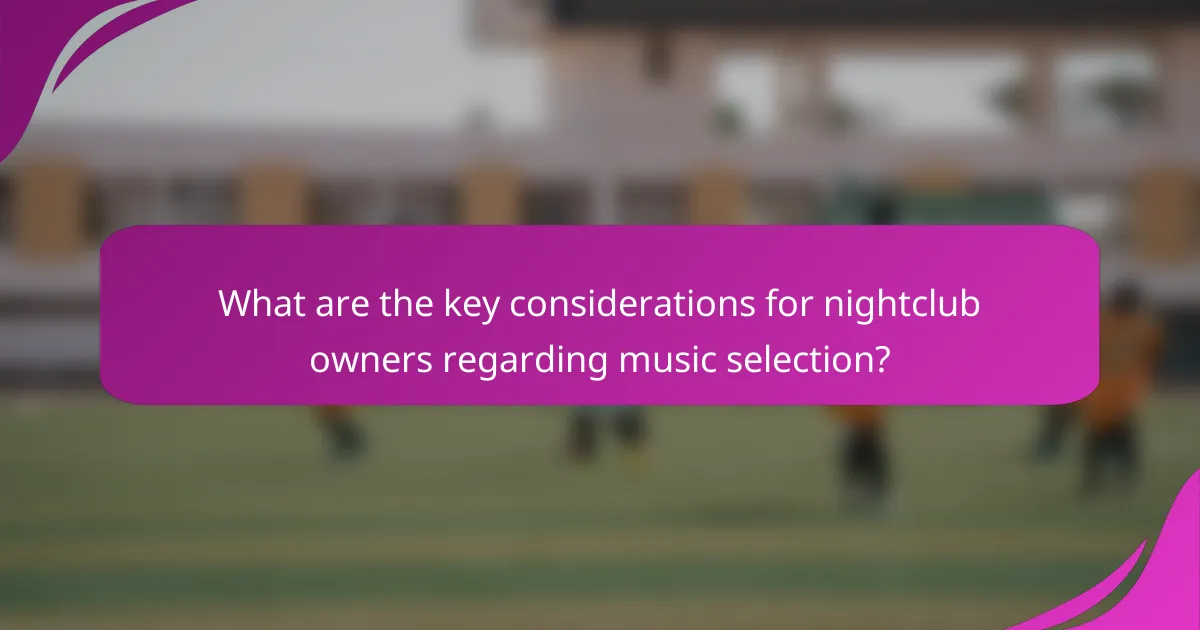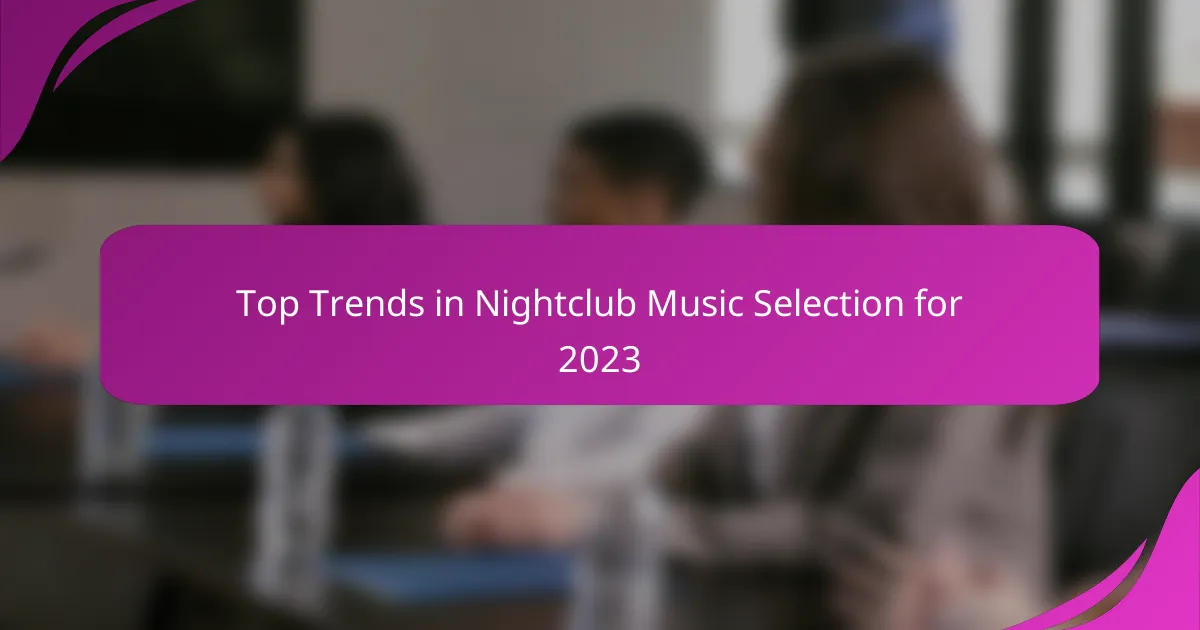The article focuses on the top trends in nightclub music selection for 2023, highlighting the increasing diversity in genres such as Afrobeat and electronic dance music. It discusses the role of DJs in shaping these trends through innovative mixing and real-time adjustments based on crowd reactions. Additionally, the article examines the impact of technology, including AI-driven music curation, and the growing emphasis on sustainability and inclusivity in music choices. It also addresses the importance of understanding audience demographics and the necessity of compliance with licensing regulations. Overall, the article provides insights into how these factors contribute to creating immersive nightlife experiences.

What are the Top Trends in Nightclub Music Selection for 2023?
The top trends in nightclub music selection for 2023 include a focus on diverse genres, such as Afrobeat and electronic dance music. DJs are increasingly blending various styles to create unique soundscapes. Live performances and collaborations with local artists are gaining popularity. There is a notable rise in the use of technology, like AI-driven music curation. Additionally, sustainability themes are influencing music choices, reflecting social awareness. Nightclubs are also prioritizing inclusive music that appeals to a broader audience. This trend aligns with the growing demand for immersive experiences in nightlife. Data from industry reports indicates a shift towards these innovative approaches in music selection.
How have nightclub music trends evolved in recent years?
Nightclub music trends have evolved significantly in recent years. The rise of electronic dance music (EDM) has dominated the scene. Genres like house, techno, and trance have gained immense popularity. Live DJ performances have become central to the nightclub experience. There is also a growing emphasis on immersive audio-visual experiences. The integration of technology, such as virtual reality, has enhanced engagement. Additionally, diversity in music styles has increased, with more genres being represented. Collaborations between artists from different backgrounds have become more common. This evolution reflects the changing preferences of club-goers seeking unique experiences.
What factors influence the evolution of music selection in nightclubs?
The evolution of music selection in nightclubs is influenced by cultural trends, technological advancements, and audience preferences. Cultural trends shape the genres and styles that are popular at any given time. For example, the rise of electronic dance music (EDM) has significantly impacted nightclub playlists. Technological advancements, such as streaming services and DJ software, allow for easier access to diverse music. Audience preferences also play a crucial role, as DJs often tailor their sets to the crowd’s energy and reactions. Additionally, social media trends can drive the popularity of specific songs or artists. Local music scenes and events can further influence selections by introducing new sounds. Overall, these factors create a dynamic environment for music evolution in nightclubs.
How do cultural shifts impact music trends in nightlife?
Cultural shifts significantly influence music trends in nightlife. These shifts often reflect changing social values, demographics, and technological advancements. For instance, the rise of social media has led to the popularity of viral dance challenges, affecting song selection in clubs. Genres like hip-hop and electronic dance music have gained prominence due to their alignment with youth culture. Additionally, movements advocating for diversity and inclusion have encouraged the incorporation of various musical styles. Research shows that clubs adapting to these cultural changes see increased patron engagement. A study by the University of Southern California highlights how cultural relevance drives nightlife attendance.
What genres are dominating nightclub playlists in 2023?
Electronic Dance Music (EDM) is dominating nightclub playlists in 2023. This genre includes sub-genres like house, techno, and trance. Hip-hop also remains a significant presence in clubs. Its popularity stems from its rhythmic beats and catchy hooks. Pop music continues to influence playlists, especially remixed tracks. Additionally, reggaeton has surged in popularity, appealing to diverse audiences. These genres reflect current musical trends and audience preferences. Data from industry reports indicate a strong preference for high-energy tracks in nightlife settings.
Which electronic music styles are gaining popularity?
Tech House and Melodic Techno are gaining popularity in electronic music. Tech House combines elements of house and techno, creating a rhythmic and danceable sound. Melodic Techno features melodic elements and atmospheric sounds, appealing to a broader audience. According to Beatport’s annual report, these genres saw significant growth in 2023. Additionally, the rise of streaming platforms has contributed to their increased visibility. Festivals and events are also featuring more of these styles, reflecting audience preferences.
How is hip-hop influencing nightclub music selection?
Hip-hop significantly influences nightclub music selection by dominating playlists and shaping the overall sound. Its rhythmic beats and catchy hooks appeal to diverse audiences. Nightclubs increasingly feature hip-hop tracks to create an energetic atmosphere. According to a 2022 report by the Recording Industry Association of America, hip-hop accounted for over 30% of all music consumption in the U.S. This trend has led DJs to incorporate more hip-hop into their sets. The genre’s collaboration with pop and electronic music further enhances its presence in nightclubs. As a result, hip-hop has become a staple in driving the nightlife experience.

What role do DJs play in shaping nightclub music trends?
DJs play a crucial role in shaping nightclub music trends. They curate and mix tracks that define the sound of a venue. Their selections often reflect current musical styles and popular genres. DJs introduce new artists and tracks to the audience, influencing listener preferences. They also respond to crowd reactions, adjusting their sets to maintain energy and engagement. This interaction helps to create a unique atmosphere that can elevate specific music trends. Furthermore, DJs often collaborate with producers and artists, contributing to the evolution of music styles. Their influence can lead to the mainstream success of underground genres. A study by the International Music Summit found that DJ sets heavily impact music chart placements.
How do DJs curate their music selections for different audiences?
DJs curate their music selections for different audiences by analyzing the crowd’s energy and preferences. They observe audience reactions to adjust their playlists in real-time. DJs often use music analytics tools to understand popular tracks and genres in specific locations. They also consider the event’s theme and time of day to select appropriate songs. Knowledge of current music trends plays a crucial role in their curation process. Additionally, DJs may communicate with event organizers to align their music choices with the audience’s expectations. This tailored approach enhances the overall experience for attendees.
What techniques do DJs use to create a unique atmosphere?
DJs use various techniques to create a unique atmosphere during performances. They blend different music genres to cater to diverse audiences. This mixing can include seamless transitions between tracks, which maintains energy and flow. Additionally, DJs often use effects like reverb and delay to enhance sound quality.
Live remixing allows DJs to personalize tracks, making them distinct. They may also incorporate live instruments or vocalists for added depth. Engaging the audience through call-and-response techniques fosters interaction. Finally, visual elements like lighting and projections complement the music, enhancing the overall experience.
How do DJs adapt to changing musical trends in real-time?
DJs adapt to changing musical trends in real-time by closely monitoring audience reactions. They analyze crowd energy and adjust their playlists accordingly. This responsiveness ensures the music resonates with the audience. DJs also utilize technology, such as software that tracks popular tracks and emerging genres. They often engage with social media platforms to identify trending songs. Real-time data from streaming services informs their selections. Additionally, DJs collaborate with other artists to stay ahead of trends. This proactive approach allows them to create a dynamic and engaging experience.
What are the emerging technologies affecting music selection in nightclubs?
Emerging technologies affecting music selection in nightclubs include artificial intelligence, data analytics, and streaming services. Artificial intelligence helps DJs analyze crowd preferences in real time. Data analytics provide insights into popular tracks and trends based on audience reactions. Streaming services offer vast libraries of music, enabling DJs to access diverse genres instantly. Additionally, mobile applications allow patrons to request songs directly, influencing the music played. These technologies enhance the overall nightclub experience by personalizing music selection and increasing engagement.
How is streaming technology changing the way DJs select music?
Streaming technology is revolutionizing how DJs select music by providing instant access to vast libraries of tracks. DJs can now explore millions of songs across genres and eras without needing physical copies. This accessibility allows for real-time updates and trends to influence their sets. Streaming platforms often feature curated playlists, which help DJs discover new music quickly. Additionally, data analytics from these platforms reveal popular tracks and emerging artists. This information enables DJs to tailor their selections to audience preferences effectively. As a result, the selection process becomes more dynamic and responsive to current musical trends.
What role do social media platforms play in music discovery for nightclubs?
Social media platforms significantly enhance music discovery for nightclubs. They allow DJs and promoters to share music directly with audiences. Platforms like Instagram and TikTok enable users to discover new tracks through viral trends. Many nightclubs utilize these platforms to showcase upcoming artists and their music. This creates a direct connection between artists and potential listeners. According to a 2022 survey by the International Music Summit, 70% of clubgoers discover new music through social media. This statistic underscores the importance of social media in shaping music preferences for nightlife. Thus, social media is a vital tool for music discovery in the nightclub scene.

What are the key considerations for nightclub owners regarding music selection?
Nightclub owners must consider audience demographics when selecting music. Understanding the age, preferences, and cultural background of patrons is crucial. The music should align with the target audience’s tastes to enhance their experience. Additionally, the timing of music selection plays a significant role. Upbeat tracks are more suitable during peak hours to energize the crowd. Conversely, softer music may be appropriate during quieter times to encourage conversation.
Another key consideration is genre diversity. Offering a mix of genres can attract a wider audience and keep the atmosphere dynamic. Furthermore, licensing and copyright compliance are essential. Nightclubs must ensure they have the proper licenses to play copyrighted music to avoid legal issues.
The use of technology also influences music selection. DJs and owners should utilize software that analyzes crowd reactions to tailor music choices in real-time. Lastly, trends in the music industry should be monitored. Staying updated with popular tracks and emerging artists can keep the nightclub relevant and appealing.
How does music selection impact customer experience in nightclubs?
Music selection significantly impacts customer experience in nightclubs. It influences mood, energy levels, and overall enjoyment. A well-curated playlist can create an inviting atmosphere. Specific genres can evoke different emotions, enhancing social interactions. Research indicates that 70% of patrons prefer venues with music that matches their personal taste. Additionally, tempo and volume affect dance behavior and engagement. For instance, faster beats can energize crowds, while slower tracks may encourage relaxation. Ultimately, effective music selection can drive customer retention and increase spending.
What strategies can nightclub owners implement to enhance music selection?
Nightclub owners can enhance music selection by analyzing audience preferences and trends. Utilizing data from social media and streaming platforms helps identify popular genres. Collaborating with DJs to curate playlists tailored to the venue’s demographic improves engagement. Implementing regular surveys to gather feedback from patrons provides direct insights into music preferences. Hosting themed nights featuring specific genres or artists attracts diverse crowds. Leveraging technology, such as music recommendation algorithms, can streamline playlist creation. Investing in high-quality sound systems enhances the overall music experience. Tracking performance metrics, like dance floor activity, can inform future music selections. These strategies collectively create a dynamic and appealing music environment.
How can understanding music trends improve nightclub profitability?
Understanding music trends can significantly enhance nightclub profitability. By aligning music selection with current trends, nightclubs can attract larger crowds. Popular music genres draw in more patrons, leading to increased ticket sales and bar revenue. Additionally, understanding trends allows for targeted marketing strategies that resonate with the audience. For example, a study by Eventbrite found that 78% of attendees prefer venues that feature trending music styles. This insight underscores the importance of adapting to musical preferences. Furthermore, incorporating live performances of trending artists can create a unique experience, encouraging repeat visits. Nightclubs that stay updated with music trends are better positioned to maximize their profits.
What practical tips can nightclub owners use to stay ahead in music selection?
Nightclub owners can stay ahead in music selection by regularly analyzing current music trends. They should monitor popular streaming platforms for trending genres and tracks. Engaging with local DJs can provide insights into what resonates with the audience. Utilizing social media to gauge listener preferences can also be beneficial. Collaborating with artists for exclusive performances can attract crowds. Hosting themed nights based on music genres can diversify the music selection. Attending music festivals helps owners discover emerging artists and styles. Finally, investing in music analytics tools can refine their selection strategy.
How can owners effectively gather feedback on music preferences from patrons?
Owners can effectively gather feedback on music preferences from patrons through surveys and direct interactions. Surveys can be distributed via mobile apps or social media. They should include specific questions about favorite genres and artists. Direct interactions can occur during or after events. Staff can ask patrons about their music experiences. Incentives like discounts can encourage participation. Analyzing data from these methods can reveal trends. This approach aligns with industry practices for improving customer satisfaction.
What resources are available for tracking music trends in nightlife?
Music trend tracking resources in nightlife include platforms like Spotify, Beatport, and SoundCloud. These platforms provide charts and playlists that reflect current popular tracks. Social media platforms like Instagram and TikTok also showcase trending music through user-generated content. Additionally, industry reports from organizations such as Pollstar and Resident Advisor offer insights into emerging trends. Music analytics tools like Next Big Sound track artist performance and audience engagement. These resources collectively help nightlife professionals stay informed about the latest music trends.
The main entity of this article is nightclub music selection trends for 2023. Key trends include the blending of diverse genres like Afrobeat and electronic dance music, an emphasis on live performances and local artist collaborations, and the integration of technology such as AI-driven music curation. Additionally, there is a growing focus on sustainability and inclusivity in music choices, reflecting cultural shifts and audience preferences. The article explores how DJs influence these trends, the evolving music landscape, and the impact of technology and social media on music discovery in nightclubs.
